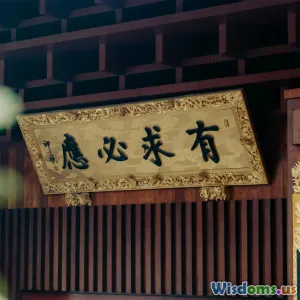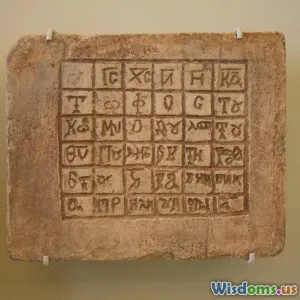
Top Five Inventions That Shaped Ancient Chinese Society
11 min read Discover the five groundbreaking inventions of ancient China that revolutionized communication, warfare, industry, and daily life, shaping Chinese society and world history. (0 Reviews)
Top Five Inventions That Shaped Ancient Chinese Society
Introduction: Ancient Ingenuity, Modern Impact
Picture a world without books, global exploration, fireworks, or even clothing as we know it. Now imagine that the brilliance of a single civilization centuries ago birthed innovations that still shape how we live today. Ancient China, with its rich tapestry of inventions, fundamentally altered the course of humanity—not just out of necessity, but through a fusion of creativity, scientific prowess, and an enduring quest to improve daily life. This article uncovers the top five inventions that both transformed ancient Chinese society and left a permanent imprint on global culture: paper, printing, gunpowder, the compass, and silk. Each represents not just a triumph of engineering or craftsmanship, but the spirit of a civilization ahead of its time.
1. Paper: Writing a New Chapter in Human Communication
The Origin and Early Use
Paper is such an essential part of modern life that it’s hard to imagine a time when it didn’t exist. Yet before its invention, people around the world relied on cumbersome materials like bones, bamboo slats, wooden tablets, silk, or animal hides for record-keeping. In 105 CE, during the Eastern Han Dynasty, court official Cai Lun is widely credited with inventing a new method of making paper by pulping together plant fibers, rag, and water. According to The Book of Later Han, “…[Cai Lun] made a paper which was white and pure and suited for writing.”
Making Information Accessible
This breakthrough democratized knowledge. Cheaper and easier to manufacture than silk or bamboo strips, paper spread from official circles to everyday life. By the third century, paper had replaced bamboo as the standard writing medium in China. By the 7th century, it had reached Korea and Japan, later spreading west via the Silk Road and transforming the Islamic world and, eventually, Europe.
Example: Paper enabled the mass production of books, sharpening record-keeping, the spread of Confucian thought, and administrational efficiency.
Enduring Legacy
Today, the word "paper trail" symbolizes stability and permanence. The book, now printed on paper, remains one of humanity's greatest tools for education and communication—a direct inheritance from ancient Chinese ingenuity.
2. Printing: Mass Communication Before the Internet
Ancient Printing Techniques
Before Gutenberg's famous mechanical printing press, Chinese inventors developed printing techniques that vastly outpaced European technologies for centuries. Chinese woodblock printing appeared as early as the Tang Dynasty (7th-10th centuries) with entire Buddhist sutras and official documents printed from carved wooden blocks. The Diamond Sutra, printed in 868 CE, is the oldest known printed book.
Fact: The Jikji, the oldest surviving metal movable type book, was printed in Korea in 1377, building on technology inspired by Chinese movements. But China’s moveable type was invented by Bi Sheng in the 11th century using clay letters.
Literacy and Cultural Expansion
By making texts reproducible, printing revolutionized education and culture. Before printing, information was prone to loss or distortion as it could only be copied by hand—a slow and error-ridden process. With printing, accurate transmission and mass production of texts became possible. Literate society blossomed, imperial exams became widely accessible, and literature thrived.
*Quote: Literary historian Endymion Wilkinson writes, "Woodblock printing led to a huge increase in the spread and preservation of information and ideas, enabling a wider evolution of culture and government." *
Global Influence
The ripple effect of Chinese printing technology catalyzed literacy in neighboring cultures, accelerated the growth of education systems, and ultimately inspired the surge of printed books in Renaissance Europe after printing migrated westwards.
3. Gunpowder: The Invention That Changed Warfare
An Alchemical Discovery
Gunpowder emerged from Daoist alchemists pursuing elixirs of immortality. Sometime in the 9th century, a blend of saltpeter (potassium nitrate), sulfur, and charcoal produced a strange effect: a combustible black powder. The oldest known formula appears in the mid-9th-century military treatise Zhenyuan miaodao yaolüe.
Early Weapons and Military Transformation
Initially, gunpowder was used for fireworks and religious ceremonies. The Chinese soon discovered its military potential. By the Song Dynasty (10th–13th centuries), rockets, bombs, grenades, and simple flamethrowers populated Chinese arsenals. The world's first true gun—a bronze hand cannon—appeared in the 13th century.
Example: The Mongol invasions and defense tactics of the Song Dynasty both featured gunpowder-based weapons, reshaping military strategy in East Asia.
Global Reach and Impact
As knowledge of gunpowder spread along trade routes, it revolutionized global warfare. By the 14th century, the technology had reached Europe and the Middle East, launching an era of cannons, muskets, and explosives. The balance between empires shifted from fortifications and swords to gunpowder-powered arsenals.
Insight: The global diffusion of gunpowder ended the age of the armored knight in Europe and transformed the power dynamics of empires worldwide.
4. The Compass: Navigating Beyond the Edge of the World
The Need for Navigation
Navigational techniques prior to the compass relied on celestial bodies, lodestones, and instincts—useful tools, but unreliable on cloudy nights or open waters. By the 2nd century BCE, the Chinese recognized the magnetic properties of lodestones and began fashioning south-pointing artifacts. By the Song Dynasty (11th century), the magnetic compass was well known, described by Shen Kuo in his Dream Pool Essays (1088).
Voyages and Discovery
A floating lodestone mounted on water or a spoon-shaped device became the standard. Mariners found the compass invaluable for navigation on foggy or overcast seas. This facilitated the growth of trade along coastal and overseas Silk Road routes.
Example: The Chinese nautical compasses enabled Admiral Zheng He’s legendary voyages in the early 15th century, connecting China with Africa and the Middle East.
Changing the World Map
The secret of the compass pushed beyond China’s borders in the 12th century, dramatically enhancing navigation throughout Eurasia and facilitating the Age of Exploration in Europe. Without the compass, there is little doubt that humanity’s knowledge of the world would have been severely delayed.
Fact: The compass made the first accurate marine charts possible—critical tools for explorers such as Vasco da Gama and Christopher Columbus centuries after the Chinese innovation.
5. Silk: Weaving Prosperity and Prestige
Sericulture’s Start
China’s mastery of silk production—or sericulture—dates back to at least 3,000 BCE. Legend has it Empress Leizu discovered silk upon noticing a cocoon fell into her tea and unwound, revealing the shimmering fiber. By the time of the Shang and Zhou dynasties, silk production was a state-guarded secret.
Economic and Social Significance
Silk was so vital to imperial China that it functioned as both currency and a symbol of social status. It played a central role in diplomacy and gift-giving; only members of the nobility or imperial family were initially permitted to wear silk garments.
Fact: The value of silk made it the namesake of the Silk Road—a vast web of trade linking China with Europe, India, Persia, and beyond.
Cultural Influence and Trade
Silk clothing and tapestries became signatures of Chinese taste and refinement. Over time, through both trade and espionage, knowledge of sericulture spread west, sparking rival industries in Korea, Byzantium, and Italy. Still, for centuries, the finest silk remained an exclusively Chinese export.
Example: Han Dynasty tombs contain beautifully preserved silk items, attesting to their value and the high level of artisan skill. Contemporary archaeological finds reveal silk burial garments designed to ensure comfort and status in the afterlife.
Conclusion: Legacy of Innovation
The legacies of paper, printing, gunpowder, the compass, and silk are woven into the fabric of global civilization—technologies first nurtured by the people of ancient China. These inventions speak not just to technical skill, but to a society’s vision: a desire to communicate knowledge, explore the unknown, defend its lands, express its values, and build prosperous, interconnected worlds.
In today's digital age, it’s easy to lose sight of our roots. But every time we read a newspaper, travel across oceans, watch fireworks explode, or appreciate a work of art, we are—consciously or not—celebrating the creativity and resourcefulness of ancient Chinese culture.
If these five inventions inspire anything, it is the timeless power of curiosity and collaboration in shaping the future. What lessons can we harness from this extraordinary legacy as individuals and as a global society today?
Rate the Post
User Reviews
Popular Posts



















